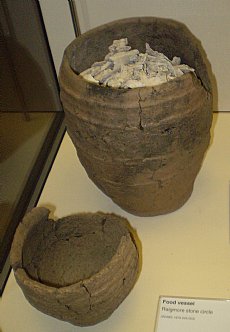Raigmore Neolithic house and Bronze Age cairn
03 January 2019
- News Type:
- Site of the Month
 When the A9 was being upgraded in the 1970s, a cairn was excavated, and then moved to behind Raigmore Community Centre. The first phase of the site is represented by some pits with grooved ware pottery, a rectangular post built structure with a hearth and a post built linear setting going northeast from the structure. Whether the building was domestic or ritual is unclear, but it is important evidence for our knowledge of Neolithic structures. The grooved ware pottery also provides evidence of late Neolithic contacts.
When the A9 was being upgraded in the 1970s, a cairn was excavated, and then moved to behind Raigmore Community Centre. The first phase of the site is represented by some pits with grooved ware pottery, a rectangular post built structure with a hearth and a post built linear setting going northeast from the structure. Whether the building was domestic or ritual is unclear, but it is important evidence for our knowledge of Neolithic structures. The grooved ware pottery also provides evidence of late Neolithic contacts.

 The kerb cairn was built respecting this building, and later had four cist burials associated with it. Antiquarian reports mention two stone circles, and the site is often cited as a clava-type cairn. However, it is atypical in several ways. No stone circle or traces of one were uncovered. The interior of the kerbs was not filled with rubble. Burials appear to have been placed beneath individual cairns, the large cairn in the centre (overlaying the timber structure) and five smaller examples. However, it does have the classic grading in height towards the southwest. The earliest burial connected with the new cairn was a cist with a food vessel, with a C-14 date of 2290-1979 cal BC.
The kerb cairn was built respecting this building, and later had four cist burials associated with it. Antiquarian reports mention two stone circles, and the site is often cited as a clava-type cairn. However, it is atypical in several ways. No stone circle or traces of one were uncovered. The interior of the kerbs was not filled with rubble. Burials appear to have been placed beneath individual cairns, the large cairn in the centre (overlaying the timber structure) and five smaller examples. However, it does have the classic grading in height towards the southwest. The earliest burial connected with the new cairn was a cist with a food vessel, with a C-14 date of 2290-1979 cal BC.
Richard Bradley has noted that there are two possible interpretations of the site. In the first, the timber building was demolished or decayed and was replaced by the central cairn, and covered a pit with cremations and grooved ware. A later phase of activity saw the monument enlarged and a boulder wall constructed to enclose the first cairn and the position of the house. Thereafter the cairn was used for burials for some time.
In the second interpretation, the structure may have been enclosed by a circular wall when it was standing or while it decayed. The outer kerb may have defined an open area outside the building. The central cairn would then have been added later once the structure had disappeared.
Regardless of interpretation, the fact remains that the Bronze Age structure respected the earlier building, and shows respect for earlier occupation. Richard Bradley also notes the importance of the cairn focussing to the southwest, while the earlier setting for the structure was to the northeast.
The excavation was noteworthy in having 19 C-14 dates. However, the phasing is difficult to determine, and the National ScARF panel recommended that further work be undertaken.
The site also has limited evidence of later use: a Roman brooch found in the top soil, and a pit with medieval glass and iron fragments, which yielded the latest C-14 date for the site of CAL AD 1280-1460 (at one sigma). This provides further evidence of Roman imports to the Highlands, and then for medieval activity in the Inverness area.
Public feeling for the monument led to it being re-assembled behind Raigmore Community Centre. Projects by the Workers’ Educational Association and Adopt-a-Monument researched details of this move. The Adopt-a-Monument project also excavated the current position.
For further information see:
Highland HER record her.highland.gov.uk/Monument/MHG3723 and associated records
Simpson, Derek D.A. 1996. ‘Excavation of a kerbed funerary monument at Stoneyfield, Raigmore, Inverness, Highland, 1972-3,’ PSAS 126, pp 53-86.
Bradley, Richard 2000. The Good Stones. A New Investigation of the Clava Cairns (Society of Antiquaries of Scotland Monography Series no. 17), 168-170.
Site of the Month Archive
- 10/04/2021 Easter Raitts township
- 02/03/2021 Lower Slackbuie, Inverness (ASDA) Neolithic site
- 01/02/2021 Balnuaran of Clava cairns
- 04/01/2021 Wilkhouse Inn
- 02/12/2020 Spinningdale Cotton Mill
- 02/11/2020 Skibo A Canadian Forestry Camp
- 01/10/2020 WWI Detonator Store, Dalmore near Invergordon
- 03/09/2020 Mesolithic Shell Midden at Sand, Wester Ross
- 08/08/2020 Kinbeachie Neolithic settlement
- 01/07/2020 Armadale Cist Burial and Stone & Timber Complex
